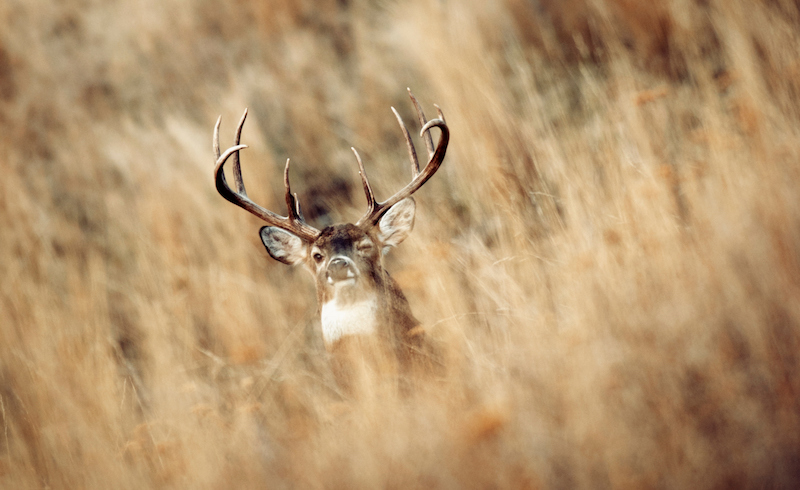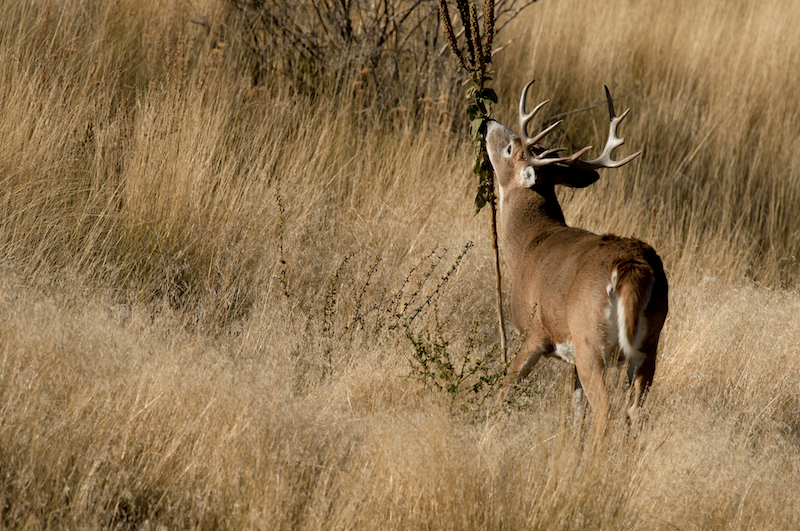Bowhunters must be quiet and stealthy to fool a deer and get into position to arrow it. By watching deer closely and interpreting their body language, you’ll know when to stand, turn or draw your bow.
Kip Adams, a wildlife biologist and conservation director for the Quality Deer Management Association, spoke with us to share what deer communicate through behaviors and body movements, and how to know when it’s OK to move.
Adams said identifying and decoding a deer’s body language often means the difference between getting busted and getting a shot. Hunters must understand what the deer’s body reveals about their awareness level, and whether you should move or remain still. Deer on high alert might flee at the sight or sound of anything, Adams said.
To learn those subtle signs, watch for these common deer actions or behaviors, and move accordingly.
When deer detect movement, they often bob their head up and down or side to side for a better look. Deer have a 300-degree field of view, but lack depth perception. Bobbing their head while staring at potential threats gives them multiple angles for identifying the risk.
If a deer bobs its head while looking your way, remain statue-still. It might have just glimpsed your movement. If it was confident it saw you move, it likely would have fled. Don’t move until the deer dismisses you, flicks its tail, and keeps browsing or walking.

Deer stomp their hooves when they sense danger to alert the herd. Photo Credit: John Hafner
Deer often stomp a front hoof if they think they see or hear something that isn’t right, but want to confirm it. Adams said the hoof stomp lets predators know the game is up. “I know you’re there.” Hoof stomping can also make predators move again. Deer stomp their hooves to show they’re alert and ready.
Remain as still as possible when deer aggressively stomp. Any sound or movement can make them flee. They might calm down if they think the threat isn’t real or disappeared.
Adams said deer hear slightly better than humans, but they have another advantage: They can rotate their ears independently of each other to capture sound from all directions. Deer constantly move their ears, so they often don’t provide clues about how they’re feeling, but they can clue you into things you likely didn’t hear.
“Deer are always listening,” Adams said. “If you pay attention to their ears, they might alert you to other deer, hunters or predators in the area.”

Deer sniff the air to analyze scents with their advanced Jacobson’s organ in their mouth. Photo Credit: John Hafner
Adams said deer interpret the world primarily through their nose. They often stick their nose high into the air to catch wind-driven scents.
“If you see them sniffing the air, it just means they got a whiff of something,” Adams said. “It’s a normal behavior. Hunters probably don’t have to worry unless they’re upwind of the deer.”
Deer usually flee when detecting human scent. That’s why it’s important to play the wind and get downwind to stay undetected.
Deer twitch their tail when relaxed, Adams said. They often do that when feeding and moving through an area. If they calmly twitch their tail while browsing, they don’t feel threatened. Make your move when the deer looks away or its vision is obstructed.
Deer spend lots of time grooming themselves and other deer, which means they’re content. Adams said you can probably get away with more movements, but err on the side of caution. Move slowly and keep vegetation between you and the deer.

Deer eat when they feel comfortable that there’s no danger. Photo Credit: John Hafner
Deer constantly browse, but don’t be fooled into thinking they’re being causal. A Quality Deer Management Association article cited research by Marty Banks, a professor of optometry and vision science at the University of California-Berkeley, who found deer see much of their surroundings, even when eating. Whitetails have horizontally elongated eye pupils, and their eyes rotate independently to align with the horizon for clear fields of view.
Move cautiously when they’re eating because they aren’t relaxed.
Likewise, don’t assume deer are tired and unsuspecting when bedded. Adams said bedded deer remain extremely alert. “Bedded deer don’t give you extra opportunities to move or make noise,” he said.
Adams said whitetails know they face higher predation risks when eating. That’s why they often eat lots of food and then bed in nearby cover so they’re protected. Once bedded, they start chewing their cud and digesting the food. Although they’re lying down, they remain aware of their surroundings.
Deer communicate by rubbing trees and scraping the ground. Bucks create a rub by raking their antlers on saplings and slightly larger trees, which often peels the bark. Scrapes are bare patches of ground, usually shaped like an oval, with a branch 4 to 5 feet above. Bucks often paw the ground, urinate into the dirt, rub overhanging limbs with their forehead and eye glands, and chew the limbs to leave scent for other deer.
Deer sometimes visit and mark scrapes year-round, and bucks start rubbing in late summer after their antlers harden. Those behaviors happen regularly during the rut. Some hunters think bucks become careless or unobservant during the rut, but Adams disagrees.
Bowhunters might have a few more opportunities to move if a buck is making ‘signpost’ communications or shadowing a doe in estrus, but they’ll flee if you spook them, Adams said.
Don’t move until you’ve assessed the situation and feel confident you’ve accurately read the whitetail’s body language. The more you observe their actions, the more you’ll avoid mistakes and make smart moves.
“With a little observation, it’s pretty easy to tell whether a deer looks calm or alert,” Adams said.